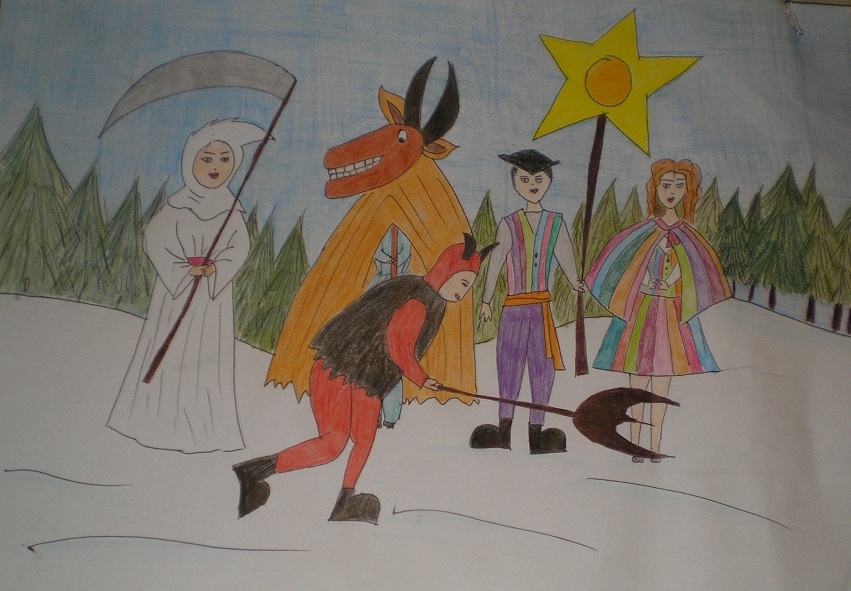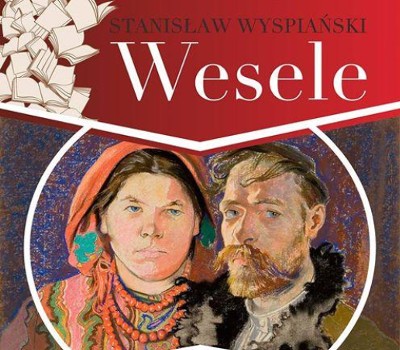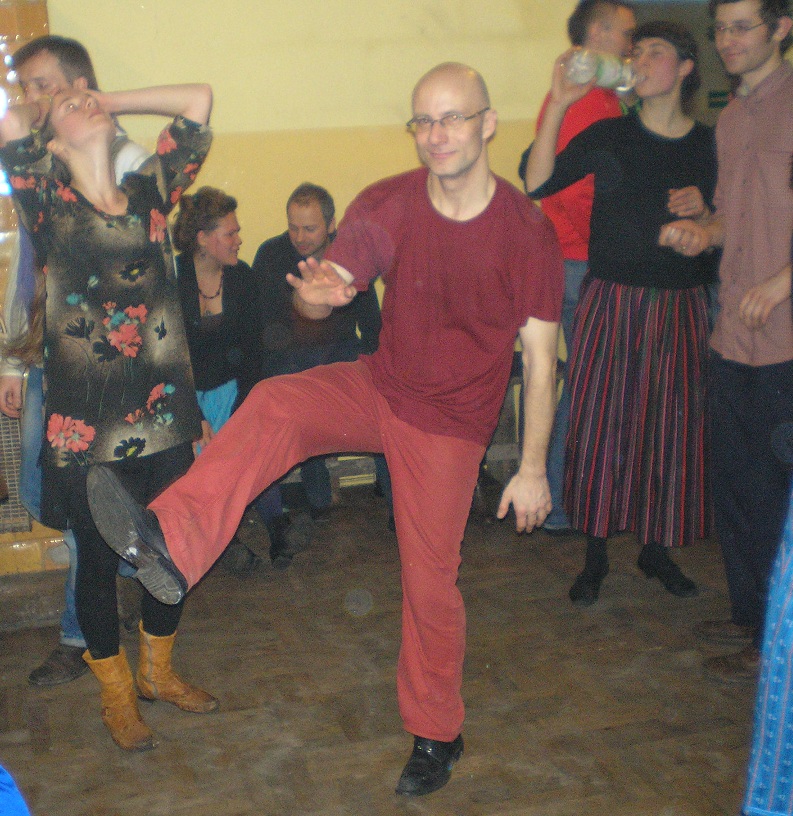 Childrens drawing of carnival costumes from in a Polish village (by an unknown artist from Przystałowice)
Childrens drawing of carnival costumes from in a Polish village (by an unknown artist from Przystałowice)
Theater art is a very important element of the Polish culture, and that is why it has an important role on the national consciousness as well. The organizers of theaters and playwriters had decisive role from the enlightenment period (which was also the era of great reforms in the Polish state and politics), and in the last decades Polish theater was associated with creativity, artistic experiments and innovation.
 Cover page of one of the editions of Stanisław Wyspiański's The Wedding with the self-portrait of the author and his wife
Cover page of one of the editions of Stanisław Wyspiański's The Wedding with the self-portrait of the author and his wife
There were some experiments to renew the theatrical art on the base of peasant culture, and this had even much more importance when the Polish state was not existed, but the intellectuals were about to keep national consciousness alive. Maybe writers and other artists of the Young Poland’s (or Young Poles’) Movement in Cracow (in the late XIX and early XXth century) had the greatest intentions to use the elements of folk art and folklore, and at the same time raise awarness of the importance of peasantry in the nation. (The most significant and direct example of this message was the symbolist play The Wedding by Stanisław Wyspiański. In foreign countries it is known for Andrzej Wajda’s movie adaptation.)
After the reborn of the Polish state and in the interwar period members of the young peasant organizations and the people’s movement continued this activity. The most famous artist amongst them was Jędrzej Cierniak. He organized many amateur theatrical workshops for young peasants in many villages, but he also co-worked with professional theaters and directed lot of performances using the elements of folklore, traditional costumes and customs on the stage. Unfortunatelly he was killed by the Germans during the Second World War. Cierniak’s successors and apprentices continued to work with folk dance performances and theatrical art rather separately, and for a while no one tried to bring the two together to create this kind of dance theater which was well-known in Hungary because of Elemér Muharay’s and István Molnár’s activity.
 Jędrzej Cierniak (in the centre, in a dark kontuś) with the actors of the Juliusz Słowacki Theater in Cracow
Jędrzej Cierniak (in the centre, in a dark kontuś) with the actors of the Juliusz Słowacki Theater in Cracow
When enthusiastic fans of folk music created Dom Tańca Foundation in the 1990s, they did not try to renew the folk dance theater for the first time, as their goal was mainly to create places and occasions for dance house parties and not for the stage. But after a few years time some of them claimed to show their activities for a bigger audience. Kind of a dance theater performance was a play under the title Black Mańka, Queen of Suburbs (Czarna Mańka, królowa przedmieścia) performed by instructors and fans of Dom Tańca and the artists of Scena Lubelska 30/32. (This was an important workshop not only for alternative theaters, but also for experiments of fine arts in 30-32 Lubelska Street, Warsaw.) This play was based on the urban folklore of the interwar period Warsaw, and used the elements of urban ballads (such as the famous Black Mańka’s Ballade) and dances like tango, foxtrott and waltz.
But the most memorable performances were those that brought traditions of different cultures together in a common theatrical experience. One of those was A Tale About a Dancing Woman (Opowieść o kobiecie, która tańczyła) by the Marebito Theater in Warsaw. The Marebito was found to popularize the Japanese culture in Poland and also to experiment some new creative ways of theatrical art on the base of the traditional Japanese drama schools and methods such as the Nō Theater. But the Tale About a Dancing Woman as a play was a special one, as it brought the elements and dances of the Japanese, Polish and Spanish (Andalusian) cultures together. It was directed by Elżbieta Jabłońska, one of the foundators of the Marebito Theater. The main character of the play was a Japanese princess (Hana Umeda) who tries to find her lost groom, a samurai (Jakub Karpoluk) and she meets different other characters on her way. These meetings and the dances of the different characters was mainly about the different views and expressions of femininity in different cultures. Two members of the cast were Japanese artists (Hana Umeda and Ishihara Rui). They performed their dances after the samples of the Japanese dramatical schools of Butō and Nihon Buyō. The others were Poles from the Marebito company and from other workshops. They all used their own knowledge of old dances and movements from different arts and schools. For example Kamila Olesińska played a Spanish girl who joins the Princess on her way. Kamila’s flamenco showed a very different type of femininity, than the Princess’ dance. Fans and instructors of the Dom Tańca created a reconstruction of a party in a Polish village. The music of the play was also created by artists of the Dom Tańca: Remigiusz Mazur-Hanaj, Agata Harz and Katarzyna Wieczerzak.
Amongst the performers of A Tale About a Dancing Woman was Grzegorz Ajdacki, who is an instructor of Polish folk dances in most of the summer camps of the Dom Tańca Foundation. He and some of his friends from Dom Tańca found another experimental company called Theater of Traditional Dances (Teatr Tańca Tradycyjnego – TTT). Grzegorz planned to perform a stage adaptation of Homer’s Odyssey with them, but without words, only in movements, based on different traditional dances. Most of these dances used by the TTT to the performance was different types and descendants of the Mazur, Mazurek or Mazurka dance. Gregorz travelled a lot in the world as a geographer and he recognized that these names of dances (mazurca, mazuca, mazur) are used worldwide. In Poland the original word ’Mazur’ means not only the dances, but also the inhabitants of Mazovia principality, so it is probable that these dances was brought to different countries by Polish emmigrants in the XIXth century. (Many of them served in Napoleon’s army, and after the defeat of the Independence War against Russia in 1830-1831 also many Poles escaped not only to France but also to French and Portugese colonies.) So the concept to the performance of the TTT was the comparison of the spread of Mazur-type dances to Odysseus’ journeys in the World.
 Grzegorz Ajdacki
Grzegorz Ajdacki
Grzegorz said that he was inspired also by Hungarian coreographers such as Katalin Györgyfalvay and Ferenc Novák to create his own Polish style of dance theatre. He also mentioned some figures of classical ballet, such as Wacław Niżyński (Polish member of Sergei Diaghilev’s Ballets Russes) and some authors of modern dance, like David Parsons as the masters, who are worth to learn from.
So the TTT company was debuted in 2011 with the theatrical dance play titled as Odysseus, the Polish Mazurek (Odys, Mazurek Polski). Grzegorz Ajdacki was the screenwriter the director and he played Odysseus’ role as well. The professional members of the cast, Magdalena Dąbrowska (who is a dancer, a puppet artist and a singer too, nowadays member of the Wierszalin Theater in Supraśl, back than she played Circe) and Barbara Derlak (who was the impersonator of the Sea Tempest in the play, and nowadays she is well-known as the singer of the folk-group Chłopcy Kontra Basia). The music for the performance was created and edited by Jacek Hałas, the multiinstrumentalist folk musician from Poznań. All the other members of the cast were amateurs, Grzegorz’s friends and fellow organizers of the Dom Tańca.
They also used their earlier knowledge and improvised from the elements of Hungarian, Romanian and Norvegian folk dances and from Brasilian capoeira as well. Łukasz Matera was maybe the most impressive actor, he danced Irish step as Polyphemos, the Cyclope. Other scenes of the play was built on the motifs of French bourrée (for the scene of the Troyan War), mazurca from the Republic of Cabo Verde (for the scenes of sailing the sea), mazurca from Gascogne (for the fight between Odysseus and Circe), Polish kujawiak (when Telemachus meets his father Odysseus), etc. The play succeded to perform almost everything by dance and without words, but because of that, the audience had to know the act of the original Odyssey to understand every element of the story.

This adaptation of the Odyssey was very impressive and creative example of the usage of Polish dances on the stage. Unfortunatelly it did not become so much known, as we and the authors hoped for the first time, and the Theater of Traditional Dances also did not act too long after that. But as I see the creative experiments and innovations of Polish theater, I am sure that the folklore will have a much more important role in the future, as in the past.
More Warsaw Return articles here
THE INTERVIEW WAS SUPPORTED BY THE WACŁAW FELCZAK FOUNDATION


A bejegyzés trackback címe:
Kommentek:
A hozzászólások a vonatkozó jogszabályok értelmében felhasználói tartalomnak minősülnek, értük a szolgáltatás technikai üzemeltetője semmilyen felelősséget nem vállal, azokat nem ellenőrzi. Kifogás esetén forduljon a blog szerkesztőjéhez. Részletek a Felhasználási feltételekben és az adatvédelmi tájékoztatóban.


